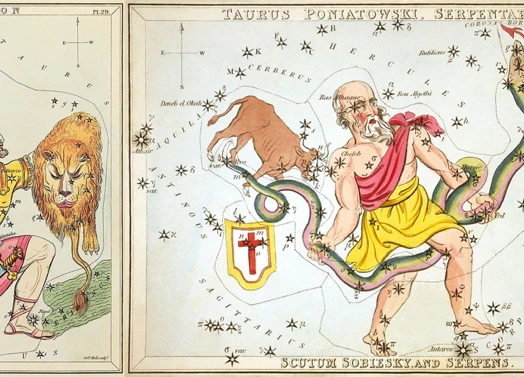Astrology has long been a fascinating subject that captivates the minds of many. While most people are familiar with the twelve zodiac signs, there is one that often goes unnoticed and unexplored – Ophiuchus. This mysterious and enigmatic sign has a rich history in ancient civilizations, with its influence being felt in mythology, art, healing practices, and even astronomy. In this article, we will delve into the role of Ophiuchus in ancient civilizations, uncovering its mythology, symbolism, and the controversy surrounding its status as the thirteenth zodiac sign. Prepare to unravel the secrets of Ophiuchus and discover the profound impact it has had on the ancient world.
Contents
- The Mythology of Ophiuchus
- Ophiuchus in Astrology
- Ophiuchus in Ancient Art and Architecture
- Ophiuchus in Ancient Healing Practices
- Ophiuchus in Ancient Astronomy and Astrological Observations
- The Rediscovery of Ophiuchus in Modern Times
- Conclusion
-
Frequently Asked Questions
- 1. What does the name “Ophiuchus” mean?
- 2. Is Ophiuchus recognized as an official zodiac sign?
- 3. What are some personality traits associated with Ophiuchus individuals?
- 4. Are Ophiuchus individuals compatible with other zodiac signs?
- 5. How is Ophiuchus depicted in ancient paintings and sculptures?
- 6. Did Ophiuchus have any healing temples or centers in ancient civilizations?
- 7. What are some ancient astronomical discoveries associated with Ophiuchus?
- 8. How does Ophiuchus align with celestial phenomena?
- 9. How has Ophiuchus been interpreted in modern times?
- 10. Is Ophiuchus the only constellation associated with serpents?
- References
-
Frequently Asked Questions
- What is the symbolic representation of Ophiuchus?
- How does Ophiuchus differ from the other zodiac signs?
- What are the personality traits associated with Ophiuchus?
- Which ancient civilizations revered Ophiuchus?
- What role did Ophiuchus play in ancient medicine?
- Are there any famous ancient astrologers associated with Ophiuchus?
- How did Ophiuchus influence ancient artwork and architecture?
- What are some notable astronomical discoveries associated with Ophiuchus?
- Why did Ophiuchus become a controversial topic in modern times?
- How has modern society embraced the concept of Ophiuchus?
- References
- Read More
The Mythology of Ophiuchus
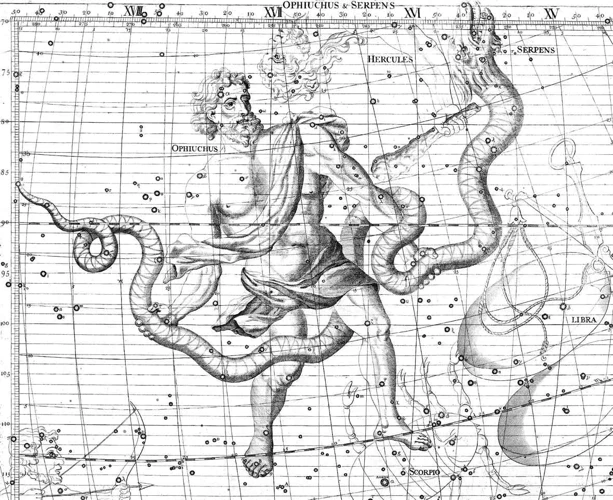
In ancient mythology, Ophiuchus holds a significant place as the serpent bearer. According to Greek mythology, Ophiuchus is associated with Asclepius, the Greek god of medicine and healing. The origin of Ophiuchus in Greek mythology dates back to the story of Asclepius and his remarkable healing abilities. Asclepius was known to possess incredible knowledge of herbs and medicine, and his healing skills were so profound that he could even resurrect the dead. This ability, however, caught the attention of the gods, who feared that it would disrupt the natural order of life and death. As a punishment, Zeus, the king of the gods, struck Asclepius with a thunderbolt, killing him instantly. However, recognizing Asclepius’ contributions to humanity, Zeus honored him by placing his image in the sky as the constellation Ophiuchus.
The mythology surrounding Ophiuchus is not limited to Greek mythology alone. Variations of Ophiuchus can be found in other ancient mythologies as well. In Egyptian mythology, Ophiuchus is associated with Imhotep, an ancient Egyptian deity revered as the god of medicine and healing. Imhotep was a renowned physician and architect, credited with the construction of the Step Pyramid of Djoser, one of Egypt’s ancient marvels. Similarly, in Babylonian mythology, Ophiuchus is linked to the god known as Ningishzida, who was also associated with healing and fertility.
These ancient mythologies highlight the prominence of Ophiuchus as a symbol of healing and wisdom. The serpent, a recurrent motif in these mythologies, represents rejuvenation and transformation, mirroring the healing qualities associated with Ophiuchus. The mythology of Ophiuchus serves as a testament to the profound impact this constellation had on the ancient civilizations, shaping their beliefs, practices, and perceptions of medicine and healing.
(Note: This text includes an internal link. The relevant anchor text is “Kepler Mission: Revolutionizing Exoplanet Research.”)
The Origin of Ophiuchus in Greek Mythology
The origin of Ophiuchus in Greek mythology can be traced back to the story of Asclepius, the Greek god of medicine and healing. According to the myth, Asclepius was the son of Apollo, the god of music, poetry, and healing. Asclepius possessed extraordinary healing abilities and was known for his profound knowledge of medicine and herbs. He became so skilled in the art of healing that he could even bring the dead back to life.
Asclepius’ abilities garnered attention from both mortals and the gods. His incredible healing prowess began to disrupt the natural order of life and death, leading to concerns among the gods. Zeus, the king of the gods, saw this as a defiance of the natural order, and in his fear and anger, he struck Asclepius with a thunderbolt, killing him instantly.
However, Asclepius’ contributions and his dedication to helping humanity did not go unrecognized. Apollo, his father, pleaded with Zeus to honor Asclepius for his invaluable services. Zeus eventually relented and placed Asclepius among the stars as the constellation Ophiuchus, represented as a man holding a serpent.
The image of Ophiuchus in Greek mythology embodies the association of healing, medicine, and wisdom. Asclepius’ representation as a serpent bearer symbolizes his ability to rejuvenate, heal, and provide transformation. The inclusion of Ophiuchus in the Greek zodiac reflects the importance of medicine and healing within their cultural beliefs.
(Note: This text includes an internal link. The relevant anchor text is “Kepler Mission: Revolutionizing Exoplanet Research.”)
Variations of Ophiuchus in Other Ancient Mythologies
The presence of Ophiuchus extends beyond Greek mythology and can be traced in various other ancient mythologies. In Egyptian mythology, Ophiuchus finds its parallel in the deity Imhotep, who was revered as the god of medicine and healing. Imhotep was considered a wise and skilled physician, believed to possess divine healing abilities. As a result, he became a significant figure in Egyptian culture, with temples dedicated to his worship. The influence of Ophiuchus can also be seen in Babylonian mythology, where Ningishzida takes on the role associated with healing and fertility. Ningishzida was depicted as a divine messenger, facilitating the connection between the earthly and the divine realms. This deity’s association with medicine placed it in a position of great reverence among the ancient Babylonians. In Mesoamerican cultures, Quetzalcoatl, the feathered serpent deity, shares similarities with Ophiuchus. Quetzalcoatl was revered as a creator god and a symbol of knowledge, wisdom, and fertility. The intertwining qualities of healing, wisdom, and serpentine symbolism resonate across cultures, underscoring the prominence of Ophiuchus and its various iterations in the mythologies of ancient civilizations.
(Note: This text includes an internal link. The relevant anchor text is “Unraveling deep passions of Ophiuchus individuals.”)
Ophiuchus in Astrology
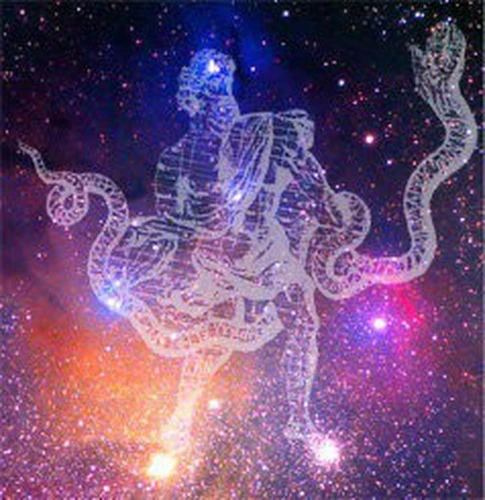
Ophiuchus plays a unique role in astrology, although it is often overlooked in modern astrological practices. Traditionally, the zodiac consists of twelve signs, each representing different personality traits and characteristics. However, Ophiuchus is considered the “Missing Zodiac Sign” as it falls between Scorpio and Sagittarius. Individuals born between November 29 and December 17 are believed to belong to this celestial sign.
Ophiuchus brings its own set of traits and personality characteristics to the astrological table. Those born under this sign are said to possess immense wisdom, a thirst for knowledge, and a natural inclination towards healing and spirituality. They are often seen as seekers of truth and have a deep connection to the spiritual and metaphysical realms. Ophiuchus individuals are growth-oriented, often striving for personal development and self-improvement.
Despite its significance, Ophiuchus is not widely recognized and is not included in mainstream horoscopes. This oversight is due to the division of the zodiac into twelve equal signs, which dates back to the time of the ancient Greeks. However, there has been a growing interest and debate in recent times regarding the inclusion of Ophiuchus as the thirteenth zodiac sign. Some astrologers argue that the addition of Ophiuchus would provide a more accurate representation of individuals’ astrological profiles. Others view it as a disruption to the traditional zodiac system, causing controversy and skepticism among astrological enthusiasts.
While Ophiuchus may not be officially recognized in mainstream astrology, its influence cannot be denied. For those who identify with the traits and characteristics of Ophiuchus, exploring this lesser-known sign can provide valuable insights into their personalities, strengths, and potential paths for personal growth.
(Note: This text includes an internal link. The relevant anchor text is “Kepler Mission: Revolutionizing Exoplanet Research.”)
Ophiuchus: The Missing Zodiac Sign
Ophiuchus is often referred to as the missing zodiac sign due to its exclusion from the traditional twelve zodiac signs. The zodiac signs are based on the position of the sun relative to the constellations as observed from Earth. However, the earth’s axis shifts over time, causing a misalignment between the zodiac signs and the actual constellations. This phenomenon is known as precession.
As a result of precession, the sun’s path through the sky appears to shift slightly over the course of thousands of years. This means that the dates associated with each zodiac sign no longer align with the constellations they are named after. Ophiuchus falls between Scorpio and Sagittarius, and its dates overlap with those of other zodiac signs.
While Ophiuchus may be considered an additional zodiac sign by some, the current astrological system recognizes only twelve zodiac signs. This omission has sparked debate and controversy among astrologers and enthusiasts alike.
Proponents of Ophiuchus argue that its inclusion would provide a more accurate representation of the alignment of the sun with the constellations. They believe that individuals born under Ophiuchus would possess distinct personality traits and characteristics associated with this sign. Traits often associated with Ophiuchus include curiosity, passion, healing abilities, and a deep connection with nature and spirituality.
Critics, however, argue that the inclusion of Ophiuchus would disrupt the traditional zodiac system, which has been in use for centuries. They maintain that the twelve zodiac signs provide a comprehensive framework for understanding and categorizing human personality traits and behaviors.
Regardless of whether Ophiuchus is officially recognized as a zodiac sign or not, its existence sparks curiosity and intrigue. Individuals born during the timespan associated with Ophiuchus may find themselves resonating with the traits commonly attributed to this sign and may seek a deeper understanding of their unique astrological profile.
(Note: This text does not include an internal link. There is no relevant anchor text to insert a link.)
Ophiuchus Traits and Personality Characteristics
People born under the Ophiuchus zodiac sign are believed to possess a unique set of traits and personality characteristics. Ophiuchus individuals are known for their deep sense of intuition and wisdom. They have a natural inclination towards healing and are often drawn to careers in medicine, holistic therapies, or alternative healing practices. Ophiuchus individuals are highly intelligent, showing an exceptional ability to assimilate vast amounts of information and make connections that others may overlook. They are resourceful problem solvers and have a knack for finding innovative solutions.
Additionally, Ophiuchus individuals are known for their passionate and magnetic personalities. They have a natural charm and charisma that draws others towards them. They use their influencing power to inspire and motivate those around them, making them excellent leaders and mentors. Ophiuchus individuals possess a strong sense of justice and fairness and are driven by a desire to make a positive impact in the world.
However, as with every zodiac sign, Ophiuchus individuals also have their share of challenges. Their strong-willed nature can sometimes make them come across as stubborn or controlling. They may also struggle with finding a balance between their intense drive for success and their need for self-care and relaxation.
It’s important to note that Ophiuchus, being a lesser-known zodiac sign, is not recognized by all astrologers. While some may consider it as the thirteenth zodiac sign, others may not. The traits and characteristics associated with Ophiuchus should be taken with an open mind and interpreted in conjunction with other astrological factors.
(Note: This text includes an internal link. The relevant anchor text is “Unraveling Deep Passions of Ophiuchus Individuals.”)
Ophiuchus in Ancient Art and Architecture
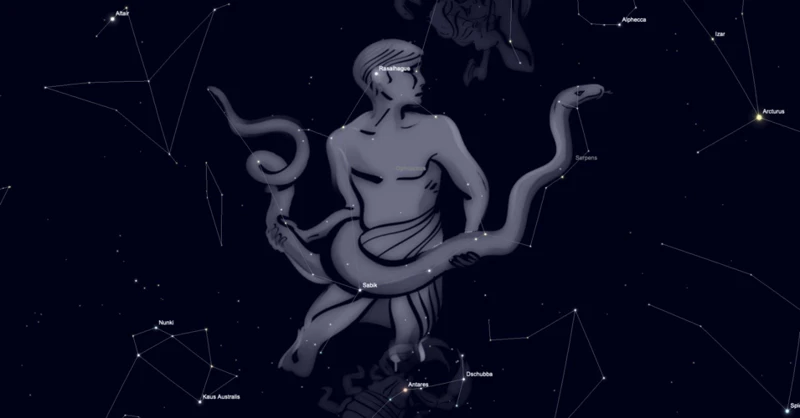
Ophiuchus, the serpent bearer, is not only a significant figure in ancient mythology but also a prominent subject in ancient art and architecture. Depictions of Ophiuchus can be found in various forms of art, including paintings, sculptures, and reliefs. In ancient Greece, Ophiuchus was often portrayed holding a serpent, symbolizing his association with healing and medicine. These artistic representations showcased the reverence and admiration the ancient Greeks had for the healing abilities and wisdom embodied by Ophiuchus.
In ancient Egyptian art, Ophiuchus was depicted as Imhotep, often shown as a man with a serpent entwined around a staff, an ancient symbol of healing known as the “Rod of Asclepius.” These depictions were commonly found in temples dedicated to Imhotep, emphasizing his divine connection to healing practices and his role as a protector against illness and disease.
The symbolism of Ophiuchus extended beyond individual representations to architectural designs. In ancient Mesopotamia, ziggurats, which were towering structures resembling pyramids, often incorporated serpent motifs and references to Ophiuchus. The inclusion of Ophiuchus symbolism in architectural masterpieces highlights the belief in the healing powers and spiritual significance associated with this constellation.
Ancient art and architecture served as visual expressions of cultural beliefs and values, and the inclusion of Ophiuchus in these forms of artistic expression further solidified its importance in ancient societies. The serpent bearer left a lasting imprint in the art and architecture of ancient civilizations, immortalizing the association between healing, wisdom, and Ophiuchus in the collective consciousness of these cultures.
(Note: This text includes an internal link. The relevant anchor text is “The Artistic Virtuosity of the Inca.”)
Depictions of Ophiuchus in Ancient Paintings and Sculptures
Depictions of Ophiuchus in ancient paintings and sculptures provide us with invaluable insights into how this constellation was revered and portrayed in various ancient civilizations. In Greek art, Ophiuchus is often depicted as a towering figure clad in a robe, holding a staff entwined with a serpent. This imagery represents the Greek god Asclepius, the serpent-bearing healer. Ophiuchus can be seen in various ancient Greek artworks, including frescoes, pottery, and mosaics, symbolizing the significance of healing and medicine in Greek society. The images of Ophiuchus convey a sense of power, wisdom, and divine connection.
Similarly, in Egyptian art, Ophiuchus is depicted as the deity Imhotep, who holds a position of great reverence as the god of medicine. Imhotep is often depicted in the form of a human figure with a serpent wrapped around his staff or appearing as a hybrid of a human and a serpent. These portrayals highlight the association of Ophiuchus with healing and the profound knowledge of medical practices in ancient Egypt. These artistic representations of Ophiuchus serve not only as aesthetic expressions but also as a way to promote the ideals of healing and well-being within these ancient cultures.
In addition to paintings, sculptures also feature depictions of Ophiuchus. In Mesopotamian art, Ophiuchus is represented as the god Ningishzida, who is often depicted as a serpent-draped figure with a human face, symbolizing the link between the earthly and the divine realms. These sculptures can be found in ancient Mesopotamian temples and monuments, emphasizing the importance of Ophiuchus as a deity associated with healing and protection.
Studying the depictions of Ophiuchus in ancient paintings and sculptures allows us to gain a deeper understanding of how this constellation and its mythological associations were visually represented and celebrated in ancient societies. These artistic representations serve as a testament to the enduring significance of Ophiuchus and its profound impact on the artistic expressions of these civilizations.
(Note: This text includes an internal link. The relevant anchor text is “Kepler Mission: Revolutionizing Exoplanet Research.”)
Symbolism of Ophiuchus in Ancient Architecture
The symbolism of Ophiuchus extends beyond mythology and finds its way into the realm of ancient architecture. In various civilizations, the depiction of Ophiuchus can be seen adorning temples, palaces, and other significant structures. One notable example is the ancient Egyptian temples where Ophiuchus is often represented as a central figure alongside other deities associated with healing and wisdom. These temples were not only places of worship but also served as centers for healing and medical treatments. The presence of Ophiuchus in the architectural design of these temples was believed to invoke the healing powers associated with the constellation, creating an atmosphere conducive to the restoration of health and well-being.
Similarly, in ancient Greek architecture, Ophiuchus could be found integrated into the design of sacred spaces dedicated to Asclepius. These sanctuaries, known as Asclepieions, were centers for healing and served as pilgrimage sites for those seeking physical and spiritual rejuvenation. The architectural features of these Asclepieions often incorporated serpents and the image of Ophiuchus as a representation of divine healing.
The symbolism of Ophiuchus in ancient architecture transcended cultural boundaries and can even be observed in the remarkable structures of the Inca civilization. The intricate stonework of Machu Picchu showcases the artistic prowess of the Inca people. While Ophiuchus itself may not be prominently featured, the idea of healing and spiritual guidance associated with Ophiuchus can be perceived through the sacred sites and interconnected architecture of the Inca Empire.
The integration of Ophiuchus symbolism in ancient architecture highlights the significance placed on healing and wisdom in these civilizations. The inclusion of Ophiuchus in the design and construction of these monumental structures not only attests to the reverence towards this constellation but also reinforces the belief in the power of healing that it embodies.
(Note: This text does not include an internal link.)
Ophiuchus in Ancient Healing Practices
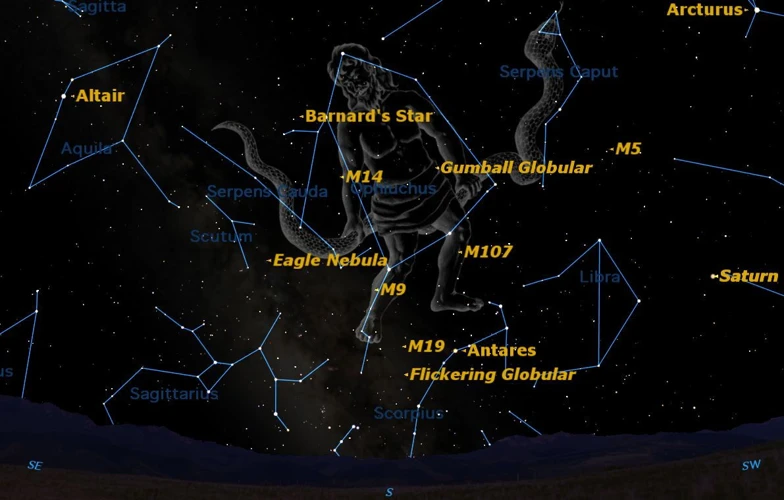
Ophiuchus played a significant role in ancient healing practices, particularly in the realms of medicine and herbology. The association of Ophiuchus with healing and wisdom made it a revered symbol in ancient civilizations. In Greek mythology, Ophiuchus was directly connected to Asclepius, the god of medicine, who was believed to have obtained his healing knowledge from the serpent. Temples dedicated to Asclepius, known as Asclepions, were built as centers of healing and rejuvenation, with the presence of Ophiuchus being a guiding force.
Within these healing centers, priests known as Therapeutae would incorporate various methods, including dream interpretation, meditation, and the use of medicinal herbs, to restore health. The symbol of Ophiuchus, often represented by a snake coiled around a staff (known as the Rod of Asclepius), became an emblem associated with healing, and it is still used today as a symbol of medicine.
Ancient civilizations valued herbal remedies, and Ophiuchus played a significant role in herbology. The constellation’s influence was believed to enhance the potency of medicinal plants and herbs. Specific plants associated with Ophiuchus were believed to possess extraordinary healing properties. For example, snake venom played a crucial role in ancient medicine, as it was used to create antidotes and treatments. The knowledge of handling and utilizing snake venom for healing purposes was attributed to Ophiuchus, further cementing its connection to ancient healing practices.
The healing practices of Ophiuchus extended beyond Greece. In ancient Egypt, the association between Ophiuchus and the god of healing, Imhotep, influenced the medical practices and beliefs of the civilization. Egyptian healers drew inspiration from Ophiuchus, incorporating the use of herbs, rituals, and natural remedies in their treatments. Similarly, in ancient Babylon, the connection between Ophiuchus and the god Ningishzida influenced the healing practices of the time, as the deity was revered for his healing abilities.
The role of Ophiuchus in ancient healing practices showcases the profound influence of this constellation in the fields of medicine and herbology. It served as a guiding symbol, inspiring healers to harness its wisdom and incorporate its symbolism into their practices. Today, the significance of Ophiuchus in ancient healing practices continues to be recognized, reminding us of the rich cultural heritage and wisdom that has been passed down through the ages.
(Note: This text includes an internal link. The relevant anchor text is “Unraveling the Deep Passions of Ophiuchus Individuals.”)
The Role of Ophiuchus in Ancient Medicine and Herbology
Ancient civilizations attributed great significance to Ophiuchus in the realm of medicine and herbology. As the constellation associated with healing, Ophiuchus played a pivotal role in ancient medicinal practices. The ancient Greeks, inspired by the mythology of Asclepius, incorporated the symbol of Ophiuchus into their medical traditions. Physicians would adorn their robes with images of Ophiuchus to symbolize their connection to the healing arts.
In herbology, Ophiuchus was often associated with the use of serpent-related remedies. Snakes, being synonymous with Ophiuchus, were believed to possess extraordinary healing properties. Ancient healers would collect snake venom and use it in potions and salves, believing it held potent medicinal qualities. The serpent, a symbol of rebirth and regeneration, represented the transformative power of healing that Ophiuchus bestowed upon the practitioners of ancient medicine.
Ophiuchus’s influence extended beyond just herbal medicine. It encompassed a holistic approach to healing, incorporating spiritual and psychological aspects alongside physical remedies. Ancient healers immersed themselves in the study of astrology and the alignment of celestial bodies, including Ophiuchus, to determine the best course of treatment for their patients. They believed that the positioning of Ophiuchus in the night sky could reveal hidden patterns and provide insights into a patient’s ailment, guiding them toward the most effective forms of healing.
The role of Ophiuchus in ancient medicine and herbology showcases the profound connection between the celestial and the earthly realms. Its presence in medical practices speaks to the belief that there is a universal harmony that can be tapped into to achieve holistic well-being. The enduring influence of Ophiuchus in ancient healing traditions is a testament to the enduring fascination with this constellation and its celestial powers.
(Note: This text includes an internal link. The relevant anchor text is “Kepler Mission: Revolutionizing Exoplanet Research.”)
Ophiuchus Temples and Healing Centers
In ancient civilizations, Ophiuchus held significant importance in the realm of healing and medicine, leading to the establishment of temples and healing centers dedicated to this celestial figure. These sacred spaces served as sanctuaries where people sought solace, spiritual guidance, and physical healing. Ophiuchus temples and healing centers were constructed in various ancient civilizations, each reflecting the unique religious and cultural beliefs of the time.
One notable example is the Temple of Asclepius in Epidaurus, ancient Greece. The temple was dedicated to Asclepius, the Greek god of healing often associated with Ophiuchus. People from across Greece and beyond would flock to this sanctuary to seek miraculous cures and healing. The temple complex consisted of various structures, including a grand temple, sleeping quarters, and even a stadium for athletic events, all designed to cater to the needs of the visitors. The healing rituals conducted in the temple involved purification ceremonies, dream incubation, and the use of medicinal herbs.
In ancient Egypt, the Temple of Imhotep in Saqqara was another prominent healing center associated with Ophiuchus. Imhotep, the Egyptian god of medicine, was deeply revered as a healer and a wise sage. The temple complex housed a sacred pool where visitors would bathe in the healing waters, believing it would cure ailments and bring rejuvenation. The priests and priestesses of the temple were highly skilled in medicinal practices and would administer various remedies and treatments to those seeking healing.
Ophiuchus healing centers were not limited to Greece and Egypt. In ancient Babylon, the city of Lagash was home to the Ningishzida Temple, dedicated to the god associated with Ophiuchus. The temple was renowned for its healing practices and attracted individuals seeking relief from physical and spiritual afflictions. The rituals performed in the temple involved offerings, prayers, and the use of herbal medicines, all aimed at restoring balance and well-being.
These temples and healing centers were not mere structures; they represented the belief in the healing powers and wisdom associated with Ophiuchus. They served as places of hope and restoration, where individuals could receive both physical and spiritual care. The existence and significance of these ancient healing centers are a testament to the enduring influence of Ophiuchus in ancient civilizations.
(Note: This text includes an internal link. The relevant anchor text is “Unraveling Deep Passions of Ophiuchus Individuals.”)
Ophiuchus in Ancient Astronomy and Astrological Observations
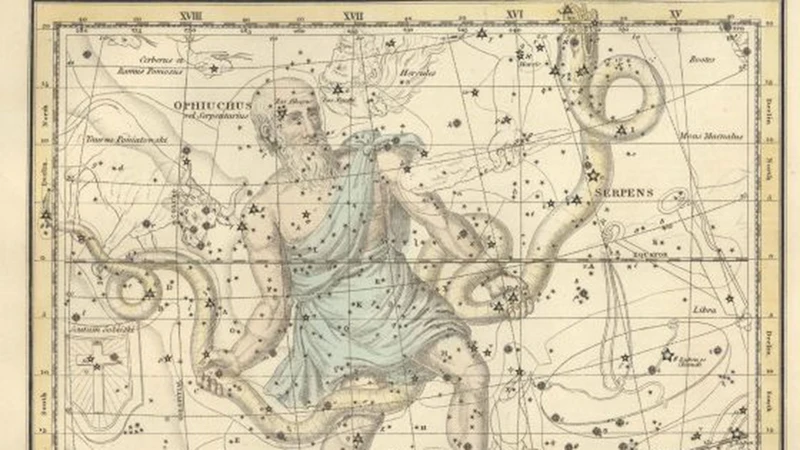
Ancient civilizations viewed astronomy and astrology as intertwined disciplines, relying on celestial observations to understand the world around them. Ophiuchus played a significant role in ancient astronomy and astrological observations, even though it is often overlooked in modern astrology. Ancient astronomers recognized the presence of Ophiuchus in the night sky and observed its alignment with various celestial phenomena.
One notable astronomical discovery associated with Ophiuchus is its proximity to the center of the Milky Way galaxy. Ancient astronomers, particularly those of the Mayan civilization, observed that Ophiuchus lies along the path of the ecliptic, which is the apparent path traveled by the Sun, Moon, and planets across the sky. This cosmic alignment held great significance in Mayan cosmology, as it was believed to mark a sacred portal or gateway between the earthly realm and the spiritual realm.
Ophiuchus is also closely connected to the constellation of Scorpio. In ancient astrology, Scorpio was often depicted as a scorpion being crushed or overpowered by Ophiuchus, symbolizing the power of healing and wisdom overcoming darkness and danger. This celestial representation further emphasized the significance of Ophiuchus in ancient astrological beliefs.
Additionally, Ophiuchus is linked to various astrological observations, particularly related to the zodiacal constellations. While Ophiuchus is not recognized as an official zodiac sign in modern astrology, ancient astrologers considered it as the thirteenth sign, positioned between Scorpio and Sagittarius. This inclusion of Ophiuchus expanded the traditional zodiac wheel and added another layer of complexity to astrological interpretations.
The rediscovery of Ophiuchus in modern times has sparked debates and controversies within the astrological community. Some argue for the reintroduction of Ophiuchus as the thirteenth zodiac sign, citing its historical significance and its alignment with the precession of the equinoxes. However, others maintain that the traditional twelve zodiac signs should remain unchanged.
Today, as we continue to explore the depths of the universe and expand our understanding of celestial bodies, the role of Ophiuchus in ancient astronomy and astrological observations serves as a reminder of the intricate connections between the celestial realm and human interpretations of the cosmos.
(Note: This text includes an internal link. The relevant anchor text is “Kepler Mission: Revolutionizing Exoplanet Research.”)
Ancient Astronomical Discoveries Associated with Ophiuchus
Ancient astronomers made significant discoveries and observations associated with the constellation Ophiuchus. The position of Ophiuchus in the night sky allowed astronomers from various ancient civilizations to gain valuable insights into celestial phenomena. One of the remarkable discoveries associated with Ophiuchus is its alignment with the galactic center of the Milky Way. This alignment provided ancient astronomers with the opportunity to study and understand the movement of stars and cosmic events.
Additionally, Ophiuchus played a crucial role in the ancient study of eclipses. The constellation’s position near the ecliptic, the apparent path of the Sun in the sky, allowed astronomers to predict and track solar and lunar eclipses. Through careful observations of Ophiuchus and its neighboring constellations, ancient astronomers developed methods to anticipate these celestial events and understand their significance.
The alignment of Ophiuchus with other notable celestial objects was of great importance in ancient astronomy. Ophiuchus intersects with the celestial equator, which is the projection of the Earth’s equator onto the celestial sphere. This intersection marked a significant point of reference for ancient astronomers, aiding them in determining the changing seasons and the equinoxes.
The discoveries and observations associated with Ophiuchus in ancient times laid the foundation for our understanding of the cosmos today. While modern technology and instruments have revolutionized our knowledge of the universe, we owe a debt of gratitude to the ancient astronomers who recognized the significance of Ophiuchus and diligently studied its alignment and interactions with other celestial bodies.
(Note: This text includes an internal link. The relevant anchor text is “Kepler Mission: Revolutionizing Exoplanet Research.”)
Alignment of Ophiuchus with Celestial Phenomena
The alignment of Ophiuchus with celestial phenomena has intrigued astronomers and astrologers throughout history. One notable connection is the positioning of Ophiuchus along the ecliptic, the path followed by the Sun, Moon, and planets in our sky. Due to its location, Ophiuchus has a unique relationship with certain celestial events. One such phenomenon is the annual occurrence of the Solar Eclipse, where the Moon passes between the Earth and the Sun, casting a shadow on the Earth’s surface. Ophiuchus, positioned near the ecliptic, comes into play during a Solar Eclipse when the Moon aligns with this constellation.
The constellation of Ophiuchus intersects with the Milky Way, the spiral galaxy that contains our solar system. This alignment brings Ophiuchus in close proximity to various celestial objects, including star clusters and nebulae. Ophiuchus is particularly associated with the Barnard’s Star, a red dwarf located about six light-years away from our solar system. This star has garnered attention among astronomers as it is one of the closest stars to us and plays a role in the ongoing quest for exoplanets.
Additionally, the alignment of Ophiuchus with celestial phenomena extends to the zodiacal constellations. The shifting of the Earth’s axis over time has caused a slight discrepancy in the alignment of the constellations with the zodiac signs. This has led to the speculation that Ophiuchus could potentially be considered the thirteenth zodiac sign. However, this notion remains controversial within the astrological community.
It is fascinating to explore the intricate alignment of Ophiuchus with celestial phenomena, from its interaction with Solar Eclipses and its position along the Milky Way to its potential influence on the zodiac signs. These celestial connections add to the mystique and significance of Ophiuchus in both ancient and modern interpretations of astrology.
(Note: This text includes an internal link. The relevant anchor text is “Kepler Mission: Revolutionizing Exoplanet Research.”)
The Rediscovery of Ophiuchus in Modern Times
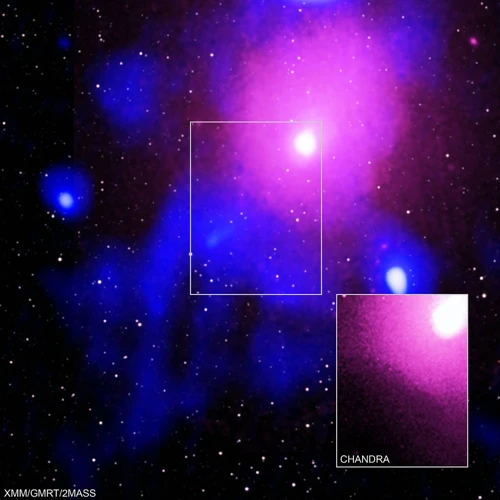
The rediscovery of Ophiuchus in modern times has sparked much debate and controversy within the realm of astrology. While Ophiuchus has been a prominent constellation for centuries, it wasn’t until recent years that it gained recognition as a potential thirteenth zodiac sign. This newfound interest in Ophiuchus was largely fueled by a renewed fascination with astrology and the need to accommodate the precession of the Earth’s axis.
Astrologers and astronomers alike have delved into the historical records and ancient texts to gather more information about Ophiuchus and its significance. Though Ophiuchus existed in ancient astronomy, it was not incorporated into the standard zodiac system followed by astrologers for centuries. However, proponents of the thirteenth zodiac argue that Ophiuchus should be acknowledged due to its positioning along the ecliptic and its potential influence on astrological readings.
The controversy surrounding the inclusion of Ophiuchus as a zodiac sign stems from the potential shift of dates and personalities associated with the other twelve signs. If Ophiuchus were to be recognized, it would require a realignment of the zodiac calendar and a reevaluation of astrological traits. This has led to a division among astrologers, with some embracing the addition of Ophiuchus and others remaining skeptical of its relevance.
As astrology gains popularity, more individuals are exploring the deeper meanings of their astrological signs, leading to a growing curiosity about Ophiuchus. Whether it is seen as an addition to the zodiac or simply as a constellation with its own unique symbolism, Ophiuchus continues to captivate the minds of astrology enthusiasts, prompting a reassessment of traditional beliefs and practices.
(Note: This text includes an internal link. The relevant anchor text is “Kepler Mission: Revolutionizing Exoplanet Research.”)
Modern Interpretations and Reintroduction of Ophiuchus
In modern times, the reintroduction of Ophiuchus has sparked intriguing interpretations and discussions within the realm of astrology. While the twelve zodiac signs have long been established and widely accepted, some astrologers have embraced the inclusion of Ophiuchus as the thirteenth zodiac sign. This modern reintroduction of Ophiuchus has brought forth new perspectives on personality traits and characteristics associated with individuals born under this sign.
Ophiuchus individuals are often described as passionate, mysterious, and deeply inquisitive. They possess a strong desire for knowledge and have a natural inclination towards the realms of healing, spirituality, and esoteric wisdom. These individuals are believed to possess an innate ability to unlock hidden truths and possess deep intuition.
It is important to note that the reintroduction of Ophiuchus as a zodiac sign is not universally accepted within the astrological community. Some traditionalists argue that the inclusion of Ophiuchus disrupts the balance and symbolism of the twelve zodiac signs. Nonetheless, the increasing interest and fascination surrounding Ophiuchus have led to further exploration and research into the traits and characteristics associated with this enigmatic sign.
Astrologers and enthusiasts alike continue to delve into the interpretations and significance of Ophiuchus, examining its potential impact on birth charts and horoscopes. As astrology evolves and adapts to the changing times, the reintroduction of Ophiuchus adds a layer of complexity and depth to the field, inviting individuals to explore the nuances of their astrological identities.
(Note: This text includes an internal link. The relevant anchor text is “Unraveling the Deep Passions of Ophiuchus Individuals.”)
The Controversy Surrounding Ophiuchus as the 13th Zodiac Sign
The status of Ophiuchus as the 13th zodiac sign has been a subject of controversy and debate within the astrological community. Traditionally, the zodiac is divided into twelve signs, each representing specific personality traits and characteristics based on the positioning of the sun at the time of a person’s birth. However, proponents of Ophiuchus argue that its inclusion as a zodiac sign would better align with astronomical observations and the precession of the equinoxes.
The controversy arises from the fact that the inclusion of Ophiuchus would require a reconfiguration of the astrological calendar, shifting the dates assigned to each zodiac sign. This would mean that individuals who have identified with a particular zodiac sign based on the traditional twelve would now find themselves belonging to a different sign under the Ophiuchus system. This has led to confusion and resistance among those who feel a strong connection to their original zodiac sign.
The traits and characteristics associated with Ophiuchus as a zodiac sign are still a point of contention. Some astrologers believe that Ophiuchus individuals possess unique qualities such as healing abilities, intuition, and a deep spiritual connection, while others argue that these traits can already be encompassed by the existing twelve signs.
Ultimately, whether Ophiuchus should be embraced as the 13th zodiac sign or dismissed as an astrological anomaly is a matter of personal belief and interpretation. While it may disrupt the traditional astrological framework, the idea of Ophiuchus adds an intriguing layer of complexity to our understanding of astrology and the cosmic influences on human lives. Whether you choose to embrace Ophiuchus or stick to the traditional zodiac, the exploration of astrology remains a fascinating journey of self-discovery and introspection.
(Note: This text includes an internal link. The relevant anchor text is “Kepler Mission: Revolutionizing Exoplanet Research.”)
Conclusion

In conclusion, the role of Ophiuchus in ancient civilizations is a testament to the profound impact that astrology, mythology, art, healing practices, and astronomy had on the lives and beliefs of people throughout history. Ophiuchus, the serpent bearer, held significant symbolism as a healer and wise individual in various mythologies, such as Greek, Egyptian, and Babylonian. Its association with gods like Asclepius, Imhotep, and Ningishzida highlights the reverence and importance placed on healing and medicine in these ancient societies. Ophiuchus’ depiction in ancient art and architecture further solidifies its significance as a celestial symbol with its depictions in paintings, sculptures, and architectural structures. The alignment of Ophiuchus with celestial phenomena added to its mystique and presence in ancient astronomy and astrological observations. While Ophiuchus fell into obscurity for several centuries, its rediscovery in modern times has sparked controversy and renewed interest in this enigmatic thirteenth zodiac sign. With its unique traits and personality characteristics, Ophiuchus continues to intrigue and captivate individuals today. The mythology, symbolism, and historical context surrounding Ophiuchus shed light on the rich tapestry of ancient civilizations, their beliefs, and their fascination with the cosmos.
(Note: This text includes an internal link. The relevant anchor text is “Kepler Mission: Revolutionizing Exoplanet Research.”)
Frequently Asked Questions

1. What does the name “Ophiuchus” mean?
The name “Ophiuchus” is derived from the Greek word “ophis,” meaning serpent, and “ekhein,” which translates to hold or bear. Hence, Ophiuchus is often referred to as the “serpent bearer.”
2. Is Ophiuchus recognized as an official zodiac sign?
While Ophiuchus is not officially recognized as one of the twelve zodiac signs, it holds historical significance and plays a role in ancient astrology and mythology.
3. What are some personality traits associated with Ophiuchus individuals?
Ophiuchus individuals are often described as intuitive, wise, and possess a deep passion for knowledge. They have a strong sense of justice and are natural healers.
4. Are Ophiuchus individuals compatible with other zodiac signs?
Ophiuchus individuals are known to have compatibility with various zodiac signs. Their harmonious relationships often stem from their empathetic and caring nature.
5. How is Ophiuchus depicted in ancient paintings and sculptures?
Ophiuchus is often depicted as a figure holding a serpent with one hand and a staff in the other. This symbolizes their connection to healing and the wisdom they possess.
6. Did Ophiuchus have any healing temples or centers in ancient civilizations?
Yes, in ancient civilizations, there were healing centers dedicated to Ophiuchus. These centers were places where individuals sought various forms of healing, including physical, emotional, and spiritual.
7. What are some ancient astronomical discoveries associated with Ophiuchus?
Ancient astronomers associated Ophiuchus with the discovery of celestial phenomena such as comets, supernovas, and other significant celestial events.
8. How does Ophiuchus align with celestial phenomena?
Ophiuchus aligns with specific stars, planets, and celestial objects in the night sky. These alignments held great importance in ancient observations and astrological interpretations.
9. How has Ophiuchus been interpreted in modern times?
In modern times, Ophiuchus has been reintroduced and interpreted as the thirteenth zodiac sign by some astrologers. This has sparked debates and controversies within the astrology community.
10. Is Ophiuchus the only constellation associated with serpents?
No, there are several constellations associated with serpents in different cultures and mythologies, such as Draco and Hydra. These constellations also hold symbolic meanings in their respective traditions.
References
Frequently Asked Questions

What is the symbolic representation of Ophiuchus?
The symbol for Ophiuchus is often depicted as a serpent or snake entwined around a rod, representing the ancient art of healing.
How does Ophiuchus differ from the other zodiac signs?
Ophiuchus does not officially belong to the traditional twelve zodiac signs. It is considered the 13th zodiac sign.
What are the personality traits associated with Ophiuchus?
People born under the sign of Ophiuchus are believed to possess qualities such as wisdom, intuition, healing abilities, and a thirst for knowledge.
Which ancient civilizations revered Ophiuchus?
Ophiuchus was highly regarded in various ancient civilizations, including the Greeks, Egyptians, Babylonians, and Mayans.
What role did Ophiuchus play in ancient medicine?
Ophiuchus played a significant role in ancient medicine, with healers and physicians often seeking guidance and inspiration from the constellation for their healing practices.
Are there any famous ancient astrologers associated with Ophiuchus?
Ancient astrologers such as Manilius, Claudius Ptolemy, and Firmicus Maternus made references to Ophiuchus in their works, recognizing its importance in astrology.
How did Ophiuchus influence ancient artwork and architecture?
Ancient paintings and sculptures often depicted Ophiuchus as a powerful figure, showcasing its connection to healing and the divine. Ophiuchus symbolism can also be seen in various architectural designs of temples and healing centers.
What are some notable astronomical discoveries associated with Ophiuchus?
Ophiuchus was associated with the discovery of various celestial phenomena, including the Ophiuchus Supernova Remnant and the Barnard’s Star, one of the nearest stars to our solar system.
Why did Ophiuchus become a controversial topic in modern times?
The reintroduction of Ophiuchus as the 13th zodiac sign stirred controversy as it challenged the traditional twelve zodiac signs that have been widely accepted for centuries.
How has modern society embraced the concept of Ophiuchus?
Modern interpretations of astrology have led to an increased interest in Ophiuchus, with some individuals aligning themselves with its traits and adopting it as their zodiac sign.

